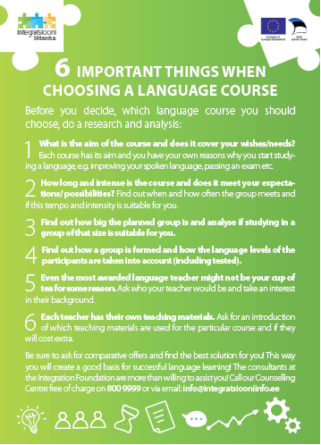Free language learning opportunities are provided by the Integration Foundation as well as Unemployment Insurance Fund. Additionally, Foundation Innove provides opportunities for compensating the expenses on learning Estonian. The program for compensating learning expenses allows each person to find a suitable course and study in the way best suited for them.
When choosing a language course to suit best your aims, ask for advice from the consultants of the Integration Foundation.
Be sure to read 6 tips for choosing a course.

Estonian learning costs are compensated for individuals in the following cases: applicants for the citizenship of the Republic of Estonia; persons sent to exams by the request of the Language Inspectorate; persons who cannot apply for compensation based on the Citizenship or Language Act, but passed the A2, B1, B2 or C1 level exam. Read additionally!
Read the Estonian learning instructions.
A welcoming program has been created for all immigrants who have arrived in Estonia less than five years ago. Within the framework of the welcoming program people can learn Estonian at the A1 level. This course is free of charge for the people who have obtained a temporary residence permit. The basic level courses give Estonian language skills that allow managing with communicating at a certain level in the Estonian language environment. After passing this course you will be able to use the common courtesy expressions, present yourself, ask and tell time, speak of what you like and do not like, order food and drink at restaurants, express simple wishes, agree on meetings, write short notices, describe how you feel, ask for and understand directions, speak about your family. More information on the language module of the welcoming program is available at welcoming program website.
Estonian language web courses Keeleklikk are meant for beginners (0–A2) and you can learn based on Russian or English. Electronic courses allow everyone studying Estonian free of charge and without restrictions. Keeleklikk.ee gives the opportunity to learn Estonian to achieve A1 and A2 levels. Keeleklikk has more than 55,000 users in Estonia and abroad.
- Achieving change in language studies takes time. It is impossible to learn a language quickly. Specialists confirm that it takes at least 6-12 months, during which time the person must work hard.
- It is impossible to just transfer language skill to someone, that is why you cannot acquire a language skill at courses or language cafes. Only the persons who work independently on a language will achieve results.
- If you lack vocabulary or you do not know the phrases, you do not command the language – that is why it is important to learn words and phrases. In the opinion of the linguists, a person is able to remember 6-10 words and phrases a day.
- Experience shows that anyone can learn a language, it is not important to be talented. People learn a language in a different manner, that is why the language learning process is different for each person.
- Don’t be afraid to make mistakes, because you cannot learn a language without making mistakes. Speaking with errors is a normal phenomenon in developing speaking skills in the learning process.
- You need to practice language to communicate, so be sure to use the possibility to participate in language clubs and language café.
Independent learner – beginner. Practical tips
- Go to https://www.keeleklikk.ee/en/welcome and create an account.
- Read the user instruction and possibilities, do not hesitate to click anywhere.
- Find the suitable starting point (first chapter might be too easy).
- Plan the language learning times, note them down in the calendar (study at least three times a week).
- After the first few times, plan a longer learning period (by which time you should pass which chapters). Make your peace with the fact that you must learn a language for at least half a year in order to achieve results.
- Take notice of what hinders your studies, make your plan into a realistic one.
- Work 30 minutes to an hour at a time.
- Make the learning environment comfortable for yourself, decrease the distracting factors.
- Repeat the material many times.
- Write down important and necessary words and phrases and learn them (e.g. place them in a visible spot, create word cards, add them to your smart device’s word-learning app etc).
- Find opportunities for using expressions in the language environment.
- Reward yourself for finishing a chapter.
- Find someone to study and share your experience with (this could be a family member, e.g. your child).
